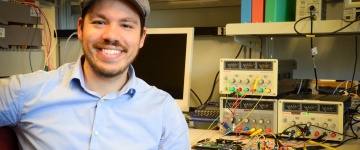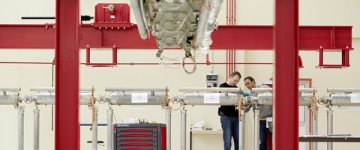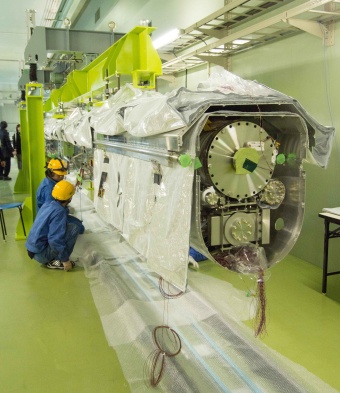Image of the week
|
|
Image: Nobuko Kobayashi
The image shows the assembly work of the cold mass for an ILC cryomodule in the superconducting rf test facility (STF) at KEK. Since the STF tunnel has a limitation for the size of the components to bring in, only half-size modules could be assembled before. STF now is equipped with new assembly facility in the tunnel, and this will be the first full-size ILC cryomodule to be assembled at KEK. This cryomodule will have a beam position monitor and a superconducting quadruple magnet in the centre, planned to be completed in December. In January, scientists will connect another half-size cryomodule, and start the cooling test in June.
|
In the News
-
from Kahoku Shinpo
3 October 2013
宮城県気仙沼市は2日、超大型加速器「国際リニアコライダー(ILC)」誘致に向け、官民による「市国際リニアコライダー推進協議会」を設立した。Kesen-numa city in Miyagi prefecture established the city’s ILC promotional body by public-private partnership on 2 October toward the invitation of the ILC.)
-
from Futura Sciences
2 December 2013
Pour aller plus loin, il faudra attendre le redémarrage du LHC en 2015. On espère surtout que les modes de désintégration du Higgs permettront d’avoir accès à de la nouvelle physique, comme la supersymétrie. Mais peut-être faudra-t-il attendre la mise en service de l’ILC pour cela.
-
from The Conversation
1 December 2013
Last week, the ATLAS experiment at the Large Hadron Collider in Switzerland, showed evidence for the first time that a Higgs boson decays into a pair of tau particles. It is one of the crucial results that has followed on from the discovery of the Higgs boson.
-
from Jiji news
30 November 2013
小林さんは「標準理論は決して究極のものではない。未知の素粒子があり、未知の相互作用がある。それが研究の大きな課題だ」と述べ、国際リニアコライダー(ILC)など次世代の計画に期待を寄せた。Makoto Konayashi said “Standard model is not an ultimate theory. There should be unknown particles, and unknown interactions. Those are the questions to solve”, expecting the next generation project such as ILC.)
-
from Nature
26 November 2013
The intent is not just to keep data for posterity. Old data can be mined to test new theories and provide crucial references for new experiments, says Diaconu. Before the Higgs boson was discovered in 2012, for example, the Large Electron–Positron collider — the LHC’s predecessor at CERN — came back into the spotlight as physicists scoured its 1990s-era data, looking for an exotic type of Higgs that had not been theorized at the time the data had been gathered.
-
from Cosmo online
25 November 2013
In week two of our particle sniper special we take a look at some of the more practical particle projects on the drawing board and explore some of the problems they will be training their sights on in the years to come.
-
from CERN Courier
20 November 2013
This year [the IOPGlazebrook Medal] goes to Lyn Evans of CERN and Imperial College London, who receives the award for “his outstanding leadership of the Large Hadron Collider Project”, the success of which ” is in large measure the result of Lyn Evans’s expertise in accelerator physics and his superb qualities as a project leader”.
-
from CERN Courier
20 November 2013
The installation of the electron injector for the European XFEL has begun at the project’s Bahrenfeld site.
-
from Český rozhlas
14 November 2013
V minulých letech neměli američtí fyzikové na tak velké projekty dost peněz. I dnes je VLHC jen jednou z možných variant strategických investic do částicové fyziky. Dalšími variantami jsou například zdokonalování samotného LHC, spolupráce na mezinárodním lineárním urychlovači v Japonsku nebo zkoumání velmi intenzivních neutrinových svazků v americké Fermiho národní laboratoři (Fermi National Accelerator Laboratory – Fermilab).
-
from KopalniaWiedzy.pl
13 November 2013
Jak zauważają niektórzy fizycy obecnie pieniądze przeznaczane są na rozbudowę LHC, który przez najbliższe dwa lata będzie udoskonalany tak, by osiągnąć maksymalne energie zderzeń, planowana jest budowa International Linear Collider w Japonii, a fizycy z USA skupiają się na wykorzystaniu bardzo intensywnych strumieni neutrino generowanych w Fermi National Accelerator Laboratory.
-
from El Diario Montanes
12 November 2013
Digamos que los aceleradores de tipo drónico, como el LHC, son esenciales para lograr grandes energías con las que hacer descubrimientos. El ILC trabajará para hacer medidas finas; aunque también podría alumbrar descubrimientos. Para entendernos, podríamos estudiar el propio Higgs con mucho más detalle.
-
from Science Guide
6 November 2013
Wat is de toekomst van het fameuze CERN? Heeft het een antwoord op de plannen voor de International Linear Collider die hoogstwaarschijnlijk in Japan gebouwd gaat worden? De Japanse overheid is bereid de helft van de kosten voor zijn rekening te nemen, dus er komt flink beweging op dit terrein op wereldschaal.
Copyright © 2025 ILC International Development Team



